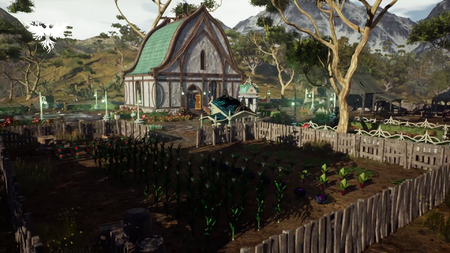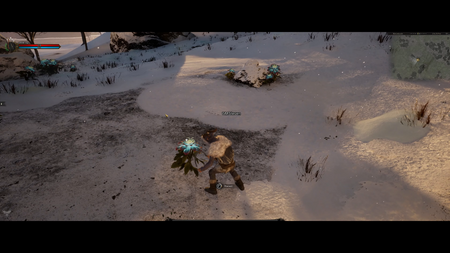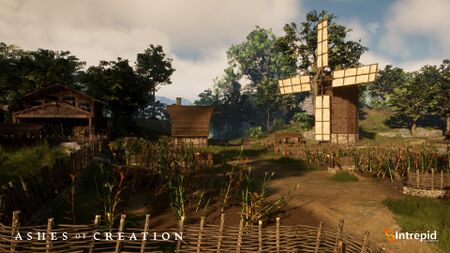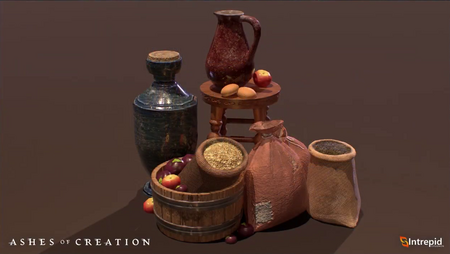Farming
Farming is generally focussed on growing crops like this and then dealing with livestock over there like that; but generally what you want to do is gather some seeds from either vendors or open-world. You can gather or find some seeds on the open content and you're going to come to your freehold and plant them; and then depending on what processing level you have and what processing stations or buildings you might have, you might grow crops like a little faster, produce better crop rotations; and just generally farm things that's unique to farming produce compared to in the open-world.[1] – Mike Han
Farming is a processing artisan profession.[1][2][3][4]
- Crops and livestock are farmable resources in Ashes of Creation.[5][1][3][6][7][4]
- Freeholds allow placement of farm workstations for farming crops and livestock.[1][1][3][6][8][4][7]
- Static housing allows placement of small garden sections for farming special types of crops.[3][6][9]
- Apartments allow placement of pots to grow seeds.[10][6]
- Public spaces in nodes allow lower-tier animal husbandry and farming activities.[11]
- The method for placing livestock and plants on a farm will vary based on available farming tools, furniture, and hired farmhands.[12]
- At first you will likely be individually placing livestock and plants and these will be based on your own efficiency in placing those footprints for those items. But, as you gain progression within either farming tools, or specific types of furniture placements, and even hired NPCs, you can move away from the low tier progression engagement with the player, which is individual placements and start doing wide swaths of placement and painting those different types of resources on the freehold.[12] – Steven Sharif
- Farmed materials can be processed into craftable materials or be converted directly into consumable items through professions such as cooking and alchemy.[3]
Freehold farms

Crops are intended in Ashes to be a rotational profession that is dependent on having the appropriate seedlings and/or any of the necessary tools.[14] – Steven Sharif
Freehold farms are workstation plots available for farming crops and livestock on freeholds.[1][1][3][6][8][4][7]
- Gathering and processing professions such as hunting, taming, and animal husbandry can benefit from having room for animals on a freehold.[5]
- Freehold permissions can be granted to allow other players to harvest resources on a freehold farm.[5]
- If farming and raising animals is important to you, then know that having room for this on your Freehold is a balancing act. Since Freeholds have space constraints, players will need to make choices about how much room they want to set aside for buildings, and where they want to do things like crop placement and rotation, and where to put livestock animals.[5]
- Artisan freehold features are also affected by adjacent terrain features. For example: building next to a river provides a nearby source of clean freshwater, and will have a positive effect on crops.[16]
Farmhands
Based on node type and progression, players will be able to hire NPCs to work as farmhands on their freehold farms.[17] Players will be able to command these farmhands in-game as well as potentially offline via an application (mobile app) or web interface.[17][18][19]
Crops
Crops are harvestable resources in Ashes of Creation.[1][3][6][7][4]
- Freeholds allow placement of farm workstations for farming crops and livestock.[1][1][3][6][8][4][7]
- The level and types of processing stations on a freehold will affect the speed and quality of crop rotations.[21][1]
- Static housing allows placement of small garden sections for farming special types of crops.[3][6][9]
- Apartments allow placement of pots to grow seeds.[10][6]
- Public spaces in nodes allow lower-tier animal husbandry and farming activities.[11]
- There'll be different types of tools and/or machinery that can be used to plant multiple seed types within a particular infrastructure that gives you bundles and/or many different harvestings that's part of progression. So, as you get more adept at farming, you have the ability to mass produce; and the same is true when you talk about quantity, speed of processing across many of the different processing professions[21] – Steven Sharif
- Crops are grown from seeds that are obtained from vendors or in the open-world.[22][1]
- Initially seeds will need to be planted individually, but the acquisition of farming tools or hired farmhands will enable more efficient methods.[12]
- Crops must be watered and fertilized until they are mature.[23][22]
- Plants can be uprooted, fruited (seeded), or harvested.[23]
- There are diminishing returns from harvesting crops, where new seeds will eventually need to be reacquired from the world.[24]
- There won't be a breeding mechanic associated with crops.[25]
- Farmable crops have applications beyond basic food items.[26]
- Farmed materials can be processed into craftable materials or be converted directly into consumable items through professions such as cooking and alchemy.[3]
List of crops
Seeds
Crops are grown from seeds that are obtained from vendors or in the open-world.[22][1]
- Initially seeds will need to be planted individually, but the acquisition of farming tools or hired farmhands will enable more efficient methods.[12]
- Plants can be uprooted, fruited (seeded), or harvested.[23]
- There are diminishing returns from harvesting crops, where new seeds will eventually need to be reacquired from the world.[24]
Livestock
Livestock are farmable resources on freehold farms.[1][3][6][7][4]
- Livestock will have process-oriented upkeep requirements, such as feeding.[23]
- Livestock can be bred by the animal husbandry profession.[29]
- Different animals produce different byproducts, such as milk or beef from cows.[5][23][28][22]
List of livestock
List of animal byproducts
Different byproducts are produced by different types of animals.[28][22]
Cooking ingredients
Livestock (and crops) are used to provide ingredients:[4]
Seasonal resources

If a particular region moves into a season and that week you can't grow a particular type of good, but another region halfway across the world can grow that good; and you talk about moving those goods across regions so that they're relevant to either craft workbenches or you can sell them in the local economies: That is a major indicator of movement of goods and movement of goods carries risks; and risks can create political foes and friends... Something as simple as just a climate can have cascading consequences across the entirety of the game.[32] – Steven Sharif
Seasons affect crops and other herbology resources available for gathering or planting, including how crop rotation is managed.[33][34][35][36]
- Seasonal variations in resource availability will impact the economy and necessitate the transit of goods between different regions.[34]
- One of the things that is huge about the season system and how it affects crops and the gatherables in the game is the impact it will have on the economy. When a particular area no longer is capable for a week's period of time, or even potentially longer, of producing a certain type of crop or harvestable; and that has to change across the world regionally, now the transit system of those materials of those gatherables they become more relevant, and they're subject to potential risk; and the prices might go up in certain areas. It is something that is actually very instrumental in the overall design of the economy in the game.[34] – Steven Sharif
- Seasons may not directly affect certain gatherables, such as veins of ore, but access to those resources may be blocked during certain weather conditions.[33][34]
- It won't likely affect too much on certain resource spectrums like veins of ore. Those might not be affected by the seasons or weather systems, but there might be blockages to cave networks that house those types of ore veins. Alternatively it is going to be significant impact on any type of herbology or plant-based types of gatherables. It's going to have significant impacts on crops that players can plant themselves on their properties; and that they'll be able to harvest. They're going to need to time the crop placement and its maturity window so that it's harvestable and available to be harvest before the change of seasons that might adversely affect certain types of crops. And not every biome will experience the same type of effects caused by the seasonality of the world. The desert biome might instead of snow have significant more winds that pick up that could be damaging to more fragile types of crops if you have a freehold in that location.[33] – Steven Sharif
Fisheries

You actually see there a small pond, which is actually another type of farmable area that we're going to have available on the freehold system, which is essentially a fishery so to speak. So fish play an important role from a raw gatherables a standpoint, but also again because a lot of the components of the freehold system are intended to be processing of raw materials, the fishery allows for a focus on specific type of fish gatherables that may only be gathered through the fishery blueprint.[14] – Steven Sharif
A fishery is a farmable workstation that can be placed on a freehold plot. A fishery allows gathering of fish that are unique to the fishery blueprint.[14]
See also
References
- ↑ 1.00 1.01 1.02 1.03 1.04 1.05 1.06 1.07 1.08 1.09 1.10 1.11 1.12 1.13 1.14 1.15 Video, June 30, 2023 (6:39).
- ↑ Livestream, October 14, 2022 (32:38).
- ↑ 3.00 3.01 3.02 3.03 3.04 3.05 3.06 3.07 3.08 3.09 3.10 Interview, February 7, 2021 (42:41).
- ↑ 4.0 4.1 4.2 4.3 4.4 4.5 4.6 4.7 4.8 Livestream, May 30, 2017 (20:01).
- ↑ 5.0 5.1 5.2 5.3 5.4 Blog: Exploring the Boundless Opportunities of Freeholds.
- ↑ 6.0 6.1 6.2 6.3 6.4 6.5 6.6 6.7 6.8 6.9 Livestream, October 30, 2020 (44:22).
- ↑ 7.0 7.1 7.2 7.3 7.4 7.5 7.6 Livestream, May 5, 2017 (32:11).
- ↑ 8.0 8.1 8.2 Livestream, October 16, 2017 (56:42).
- ↑ 9.0 9.1 Livestream, June 26, 2020 (45:32).
- ↑ 10.0 10.1 Interview, July 9, 2023 (41:22).
- ↑ 11.0 11.1 Interview, July 9, 2023 (51:26).
- ↑ 12.0 12.1 12.2 12.3 Interview, September 10, 2023 (29:31).
- ↑ 13.0 13.1 Livestream, May 29, 2020 (35:36).
- ↑ 14.0 14.1 14.2 Livestream, May 29, 2020 (39:47).
- ↑

- ↑ Livestream, May 5, 2017 (15:47).
- ↑ 17.0 17.1 17.2 17.3 Interview, July 9, 2023 (1:37:34).
- ↑ 18.0 18.1 18.2 Livestream, May 9, 2017 (28:57).
- ↑ 19.0 19.1 19.2 Livestream, November 17, 2017 (11:00).
- ↑ X.com - Verran screenshots.
- ↑ 21.0 21.1 Livestream, June 30, 2023 (1:47:33).
- ↑ 22.0 22.1 22.2 22.3 22.4 Video, June 30, 2023 (11:53).
- ↑ 23.0 23.1 23.2 23.3 23.4 Livestream, June 30, 2023 (1:46:24).
- ↑ 24.0 24.1 Interview, July 9, 2023 (55:54).
- ↑ Interview, February 7, 2021 (44:17).
- ↑
- ↑ Video, June 30, 2023 (12:14).
- ↑ 28.0 28.1 28.2 Video, June 30, 2023 (12:57).
- ↑ Video, June 30, 2023 (7:37).
- ↑ Twitter - Killing virtual pigs is no laughing matter!
- ↑ Video, October 28, 2022 (19:10).
- ↑ Livestream, April 29, 2022 (56:24).
- ↑ 33.0 33.1 33.2 Livestream, May 27, 2022 (55:47).
- ↑ 34.0 34.1 34.2 34.3 Video, May 27, 2022 (15:50).
- ↑ Livestream, May 8, 2017 (20:27).
- ↑


